Discover how to install the Meta Pixel, track website actions, and increase your Facebook ad ROI with this guide.
The Meta Pixel (formerly known as the Facebook Pixel) is a piece of code you insert on your website, with an almost magical ability to provide insights into your site's visitor behavior.
It's a secret weapon from the Facebook toolbox designed to elevate your advertising efforts, empowering you to measure, optimize, and build better audiences for your advertising campaigns.
Every time a user visits your site and takes an action (like buying your product), the Facebook Pixel is triggered and reports this activity. This allows you to understand your customer's journey better, from the moment they see your Facebook ad to the final conversion on your website.
While the Pixel can seem like just another task to complete, the truth is that it drastically enhances your Facebook advertising strategy. Whether you're looking to understand your audience better, improve your targeting, or even be able to track how much revenue you're generating from your ads, the Facebook Pixel stands as an invaluable ally.
By harnessing its power, you can track users as they interact with your website and Facebook ads and monitor just how much profit you receive as a result, which, in turn, enables a more nuanced, data-driven marketing approach.
Without further ado, let's dive into this guide to learn how to create and implement the Meta Pixel!
Setting up Meta Pixel on your website
Creating a Meta Pixel
First up, we need to create our Pixel so that we can install it on our website. To do so, follow these easy steps:
- Go to your Facebook Events Manager.
- On the left side menu, click “Connect Data Sources.”
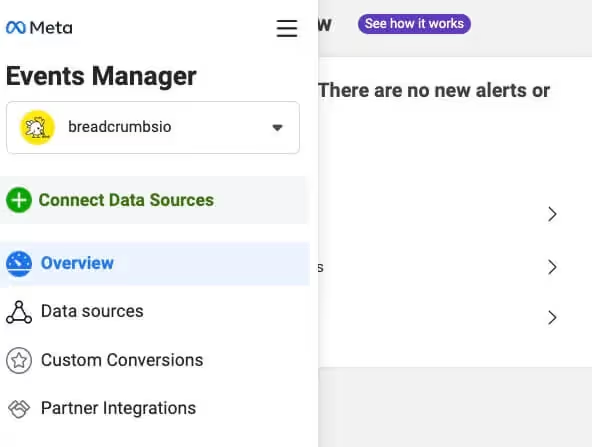
- Select “Web” and click “Connect.”
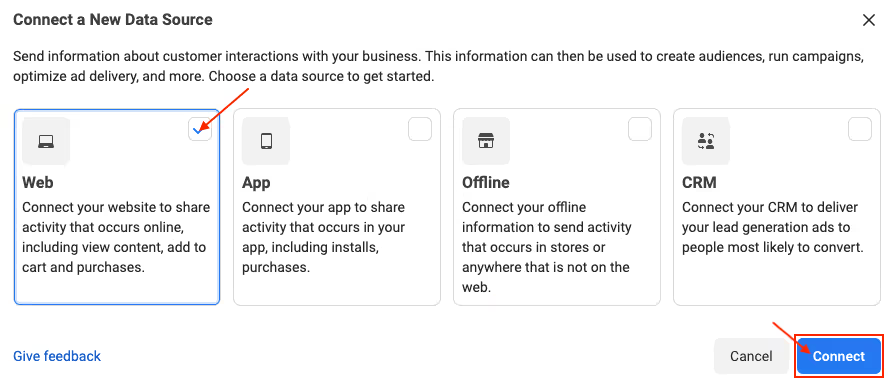
- Select a name for your Pixel and click "Create Pixel."

- You can now enter your website URL to check for easy setup options via the partner integrations.
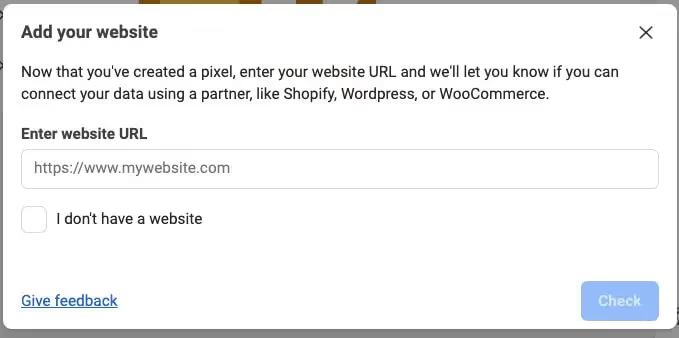
And there you have it! Your Pixel has been created, but we're not finished just yet.
Installing the Pixel code on your website
There are 2 main ways you can install your Pixel—by manually editing your website's code and adding the Pixel or by using a partner integration. You can also send the instructions to your web developer for them to complete this part instead.
If you are comfortable installing the code yourself, you can keep on reading. If you want to use a partner integration instead or email this code to your developer, skip ahead to the next sections.
How to Manually add the Meta pixel code to your website
- If you want to use one of the integrations, skip to the next part of this article. Otherwise, click the “Do it yourself” option and select “Next.”
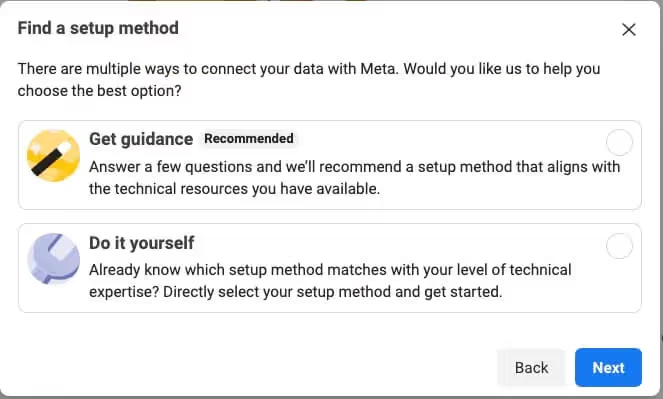
7. In the next step, it’s going to ask us if we want to use the Conversions API and the Pixel or just the Meta Pixel. We’re going to go with the “Meta Pixel only” option now and come back to the Conversions API section in a bit.
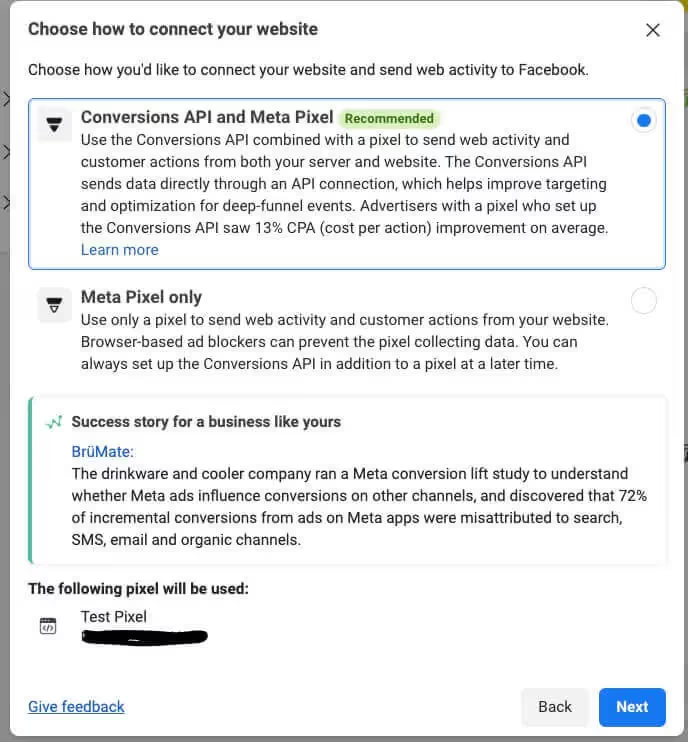
8. Next, we’re going to click the ”Install code manually” option.
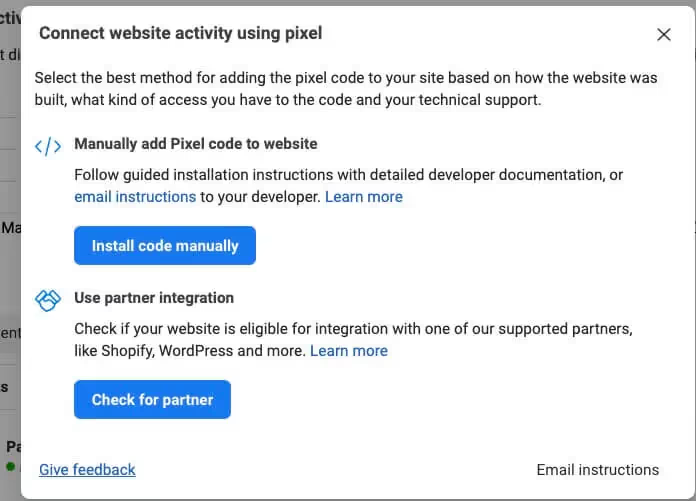
9. On the next page, Facebook is finally going to give us our code. Woohoo! Now we can copy this code and head on over to our website to install it.
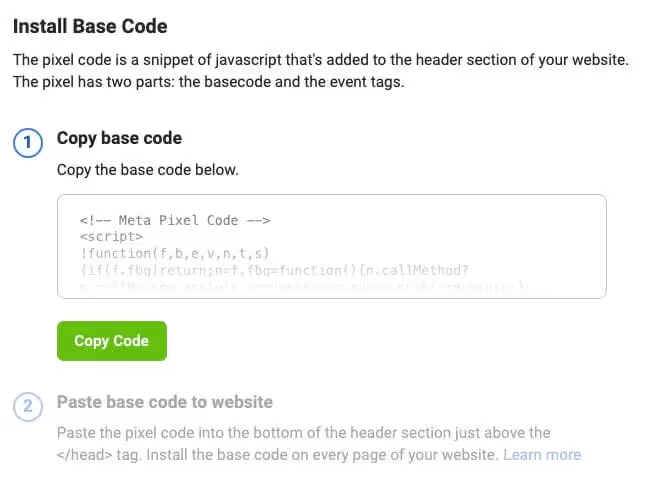
The next steps will vary depending on what CMS or web platform you use, but at any rate, your goal is to add this code to the header tag of your website.
Given that these platforms are ever-changing, we recommend that you consult your specific CMS guide for how to add the code to your website. You can find installation guides for WordPress here.
Integration with other platforms
If you're not comfortable installing the code yourself, that's okay too. There are several useful partner integrations that allow you to quickly add the Pixel to your website without all the hassle.
How to Install the Meta Pixel with a partner integration
- For this step, you can either click on the “Check for partner” button from step 8 above or got to your Events Manager dashboard and click “Partner Integrations” on the left side menu.
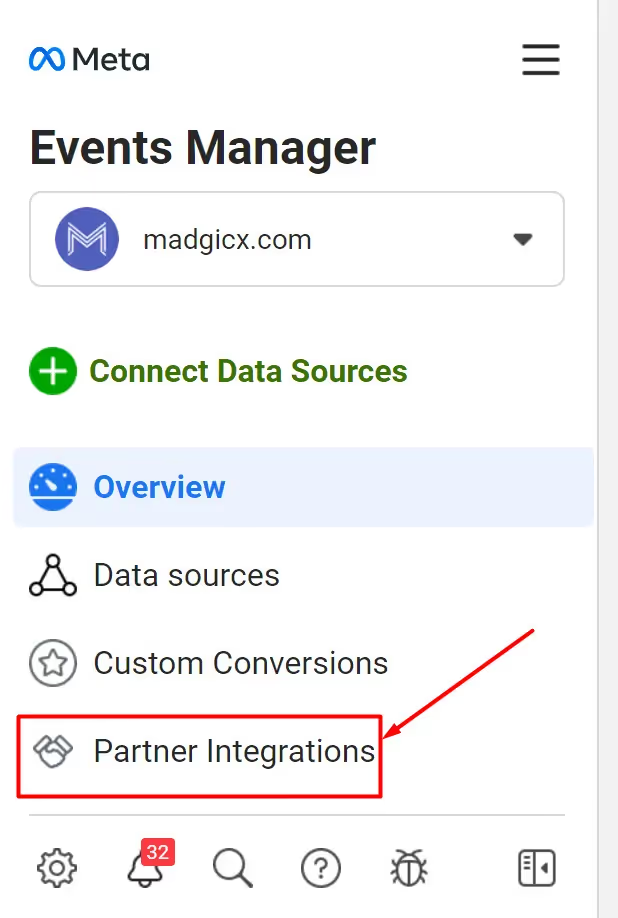
2. Select the relevant partner from the list.
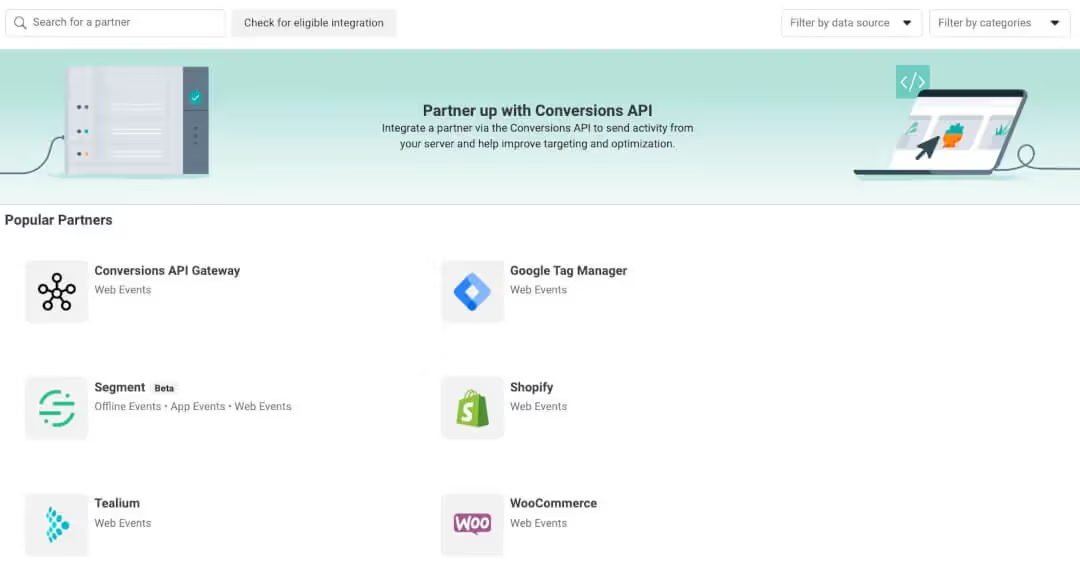
3. Follow the on-screen setup instructions.
Facebook has integrations for various website and eCommerce platforms, including:
In addition, Facebook has an integration for Google Tag Manager and for many customer data platforms, data connection platforms, CRM and marketing software, and mobile platforms.
Send instructions via email
If someone else, such as your web developer, will be doing the Meta pixel setup on your website for you, you can easily send them the instructions by email.
- Click “Email instructions” at the bottom right of the popup:

- Enter the recipient’s email address.
- Click “Send” at the bottom of the page.
A note on the Conversions API
Since iOS 14, Apple limits the data that’s passed from third-party providers back into Facebook via the pixel. To comply with this new law, Meta released the Conversions API feature, which is meant to be a more secure (and data-filled) way to transmit conversion data back to Facebook.
Typically, this is done through partner integrations like those found above. If you want to implement the Conversion API, you'd need to use a partner tool that supports Conversions API and then follow the steps outlined to turn this feature on.
However, it’s important to note that this feature doesn’t *technically* fix the full problem. Given that these partner integrations are still a third party (i.e., the data from your audiences is still being passed back and forth through an intermediary), you’ll still find that the data you get from these is incomplete.
In order to fix these issues, you need to use the Conversions API Gateway. By using the Conversion API Gateway instead of the basic Conversion API setup, you can pass data directly from your hosting server to Facebook—meaning you become the first-party data provider and thus comply with Apple’s official iOS privacy rules.
While setting up this tracking is no easy feat, it’s one of the best ways to recapture lost data due to Apple’s privacy regulations. And to make things even easier, the Madgicx Cloud Tracking team is ready to solve this issue once and for all.
With the Madgicx Cloud Tracking services, the team will take the reins and complete the entire Server-to-Server connection for you.
In addition, we’ll also tackle Enhanced Conversions. This extra step allows you to store user data using first-party cookies as users move through your website, allowing for the maximum amount of tracking data to be sent to Facebook.
And here’s the cherry on top - the whole process takes just 2 days to get up and running. Plus, you’re looking at a data buffet with at least 20% higher ROAS and more conversions tracked. And the best part is: you can try it for 7 days for free!
If you’re ready to dive headfirst into tracking nirvana, get the lowdown on Madgicx Cloud Tracking and take the plunge right here.
How to find Meta (Facebook) Pixel ID
When installing the Pixel through a partner integration or WordPress plugin, it might ask for your Pixel ID instead of the code we had the chance to copy and paste earlier.
If you need your Pixel ID, you can find it by going to Events Manager and clicking on the “Data sources” tab.
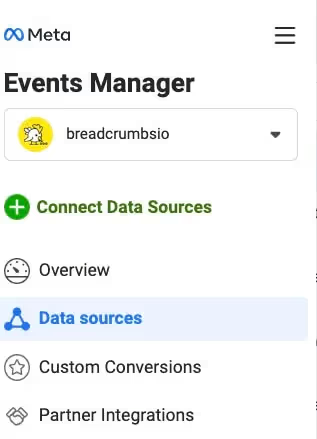
You’ll then find the Pixel ID right under the name of your pixel.
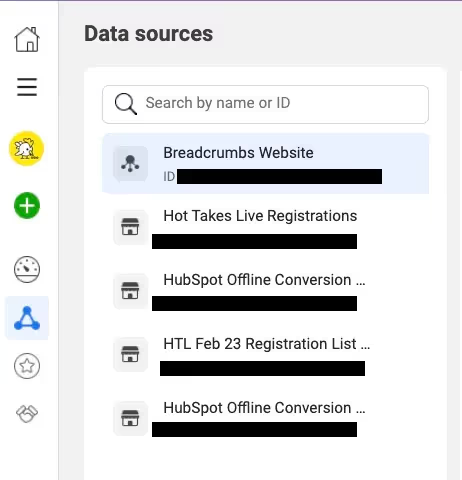
How to set up Facebook Pixel events with the Event Setup Tool
While the Pixel is able to track page views by default when set up, there are a ton of other things it can track for you. These actions are called events.
Pixel events relate to specific actions that are taken on your site. There are several different types of standard events, but the most important ones for eCommerce are:
- Add To Cart: Triggered when someone adds a product to their cart.
- Add Payment Info: Triggered when someone adds their payment information during checkout.
- Initiate Checkout: Triggered when someone clicks on the checkout button.
- Purchase: Triggered when customers complete a purchase and view the confirmation page.
- Search: Triggered when users search for information or products in the store.
- View Content: Triggered when a visitor visits any page on your website, like a product details page.
You can also create custom conversions if you want to track something that isn't explicitly stated above or something that has a specific value to you (more on that in a second).
Note that you can also turn on Automatic Events, which allows your Meta pixel to automatically track valuable events, such as purchases and registrations, without having to set them up.
Automatic Events will be de-duplicated from any other events you have manually set up.
In order to enable Automatic Events, just click on your Pixel name, head to the Settings tab, and scroll down to find the automatic tracking toggle.
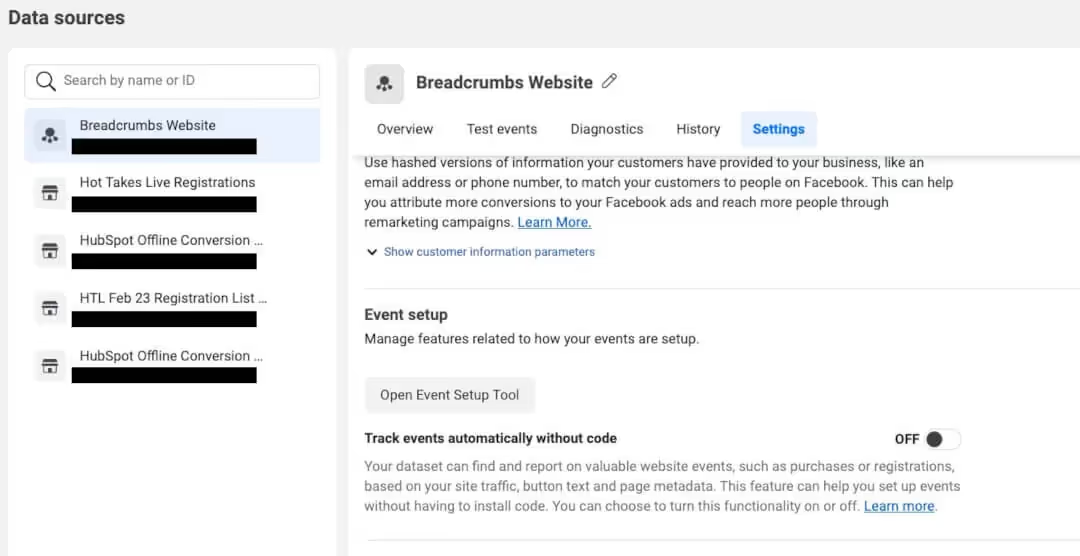
Pro Tip: If your business is in a regulated vertical, you won’t be able to use the Event Setup Tool and need to set up your events manually. The regulated verticals are investment banking and brokerage, insurance, financial services, retail, credit union and commercial banking, credit, financing, mortgages, pharmaceutical, and health.
To set up standard events on your website, follow the following steps:
- Click on the Open Event Setup Tool from the Settings page we were just on.
- Enter your website’s URL and click “Open Website.” Ensure you write the full URL with HTTP(s) at the beginning.
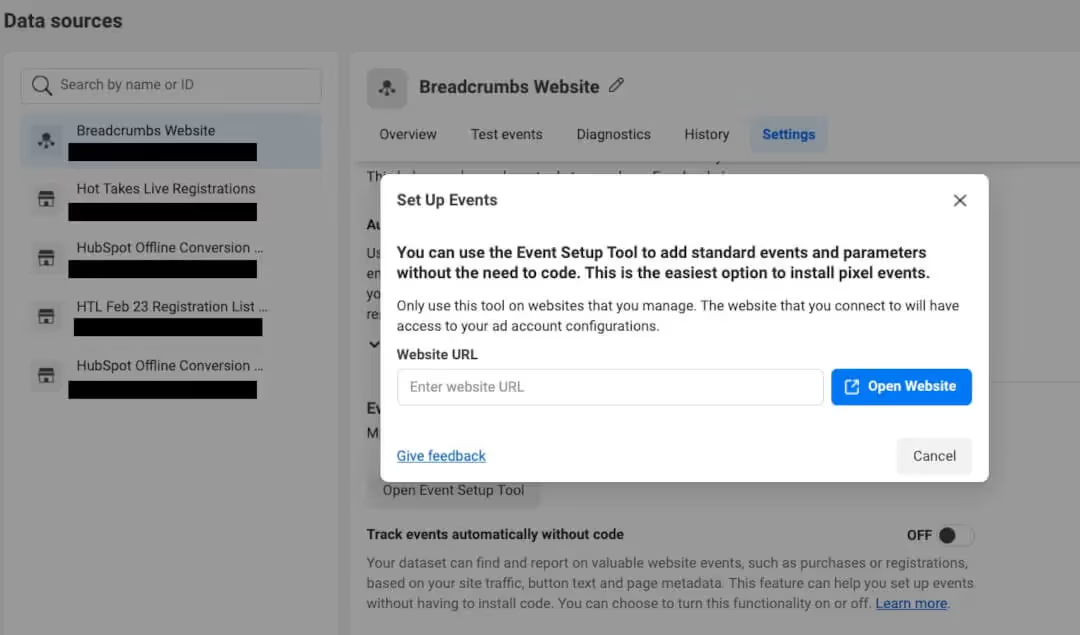
3. The Event Setup Tool should open up on your website. If it doesn’t, try turning off your ad blocker.
4. You can now go through each page on your website and add a button click or URL tracking. You can also view the details of your current events and edit or delete them.
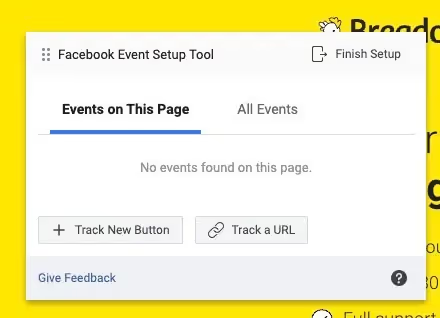
5. You can also go to the “All Events” tab to view, edit, or delete events you set up on other pages on your website.
6. Note: if you set up an event manually in your website code, you won’t be able to view its details, edit, or delete it using the Event Setup Tool.
7. Once you’re finished, click “Finish Setup” or go back to the Events Manager and click “Disconnect.”
How to create a custom conversion
- Go to Events Manager and select “Custom Conversions” on the left-side menu.

- Click “Create custom conversion."
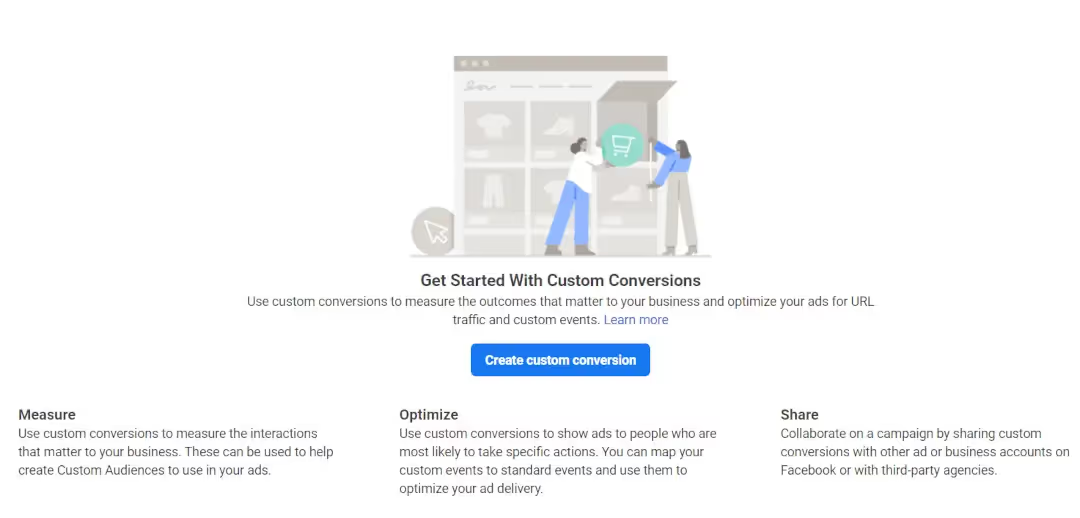
- Give your custom conversion an indicative name. You can also add a description for further clarification.
- Choose your relevant pixel as the data source (in case you have more than one pixel).
- Select the type of conversion event you wish to optimize for. You can select each of the standard conversions you installed, All URL Traffic, or a custom event if you created any (more on that later).
- Add the rules. These rules can be URL-based, domain-based, or event parameters. Read the list of all the available parameters.
- You can also enter a conversion value to tell Meta how much this conversion is worth for you. This is helpful for monitoring your ROAS. If you don’t enter any value, it’ll default to zero.
- Click “Create.”
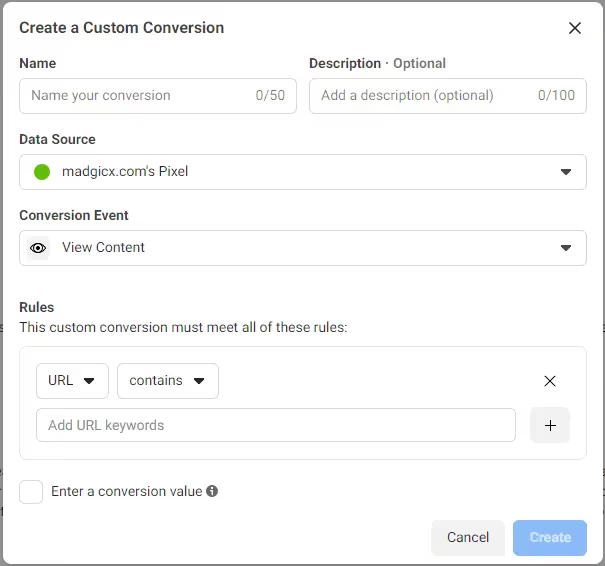
Note that every ad account is limited to 100 custom conversions. That limitation is not per Pixel but per account. However, you can delete custom conversions you aren’t using anymore and create new ones instead. Also, note that you can’t use custom conversions with Dynamic Product ads (now called Meta Advantage+ catalog ads).
Custom events
The next level of customization is called “custom events.” These events are needed when you have important steps of the funnel that are not included in the standard ones. Every step of your funnel should trigger a Pixel event. For example, if you have a multistep questionnaire, your Pixel can fire an event for each step of the form.
In order to create custom events, you have to add the relevant Javascript code to the relevant page on your website. While custom conversions are tied to a URL, custom events can be called also when a visitor performs an action like clicking a button.
Pro Tip: Don’t create custom events that are meant to replace standard pixel events. If Meta has already created a standard event, such as Purchase, for example, use it when the event is a purchase. Meta knows best how to find people who are likely to purchase and will optimize your ads for this type of conversion if you set it up correctly. However, if you create a custom event that is meant to replace it, Meta won’t be able to optimize for it properly, and you might miss out on potential customers.
Testing the Pixel installation with the Meta Pixel Helper Chrome extension
Now that you've created and installed your Pixel, you'll want to check and make sure it's set up and working fine. The easiest way to do this is with the Meta Pixel Helper extension for Chrome.
(It's also commonly referred to as the Facebook Pixel Helper, Pixel Checker, or any combination of those words, but Meta Pixel Helper is the new official name)
The Meta Pixel Helper will show you whether your pixel is active in addition to helping you troubleshoot errors if any are found. If your Meta Pixel is not active, you'll know right away using this extension.
How to install the Meta Pixel Helper Chrome extension
- Use this link to add the Meta Pixel Helper Chrome extension to your browser.
- Go to your website.
- If your Pixel is working, the Pixel extension icon will turn blue and show the number of active Meta pixels on the website.
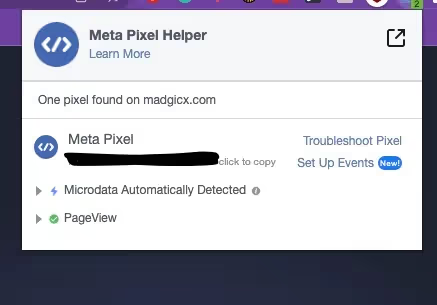
4. Click on the extension icon and make sure the Pixel installed on your website has the same ID as the one you see in the Events Manager.
5. In this popup, you can also check whether your pixel is working properly. If not, an error notification will appear.

- If you discover any issues, you can troubleshoot them on the Events Manager.
Using Facebook Pixel to improve marketing campaigns
The hard part of installing the Facebook Pixel code is finally over, and now we're ready to reap the sweet data rewards that come with it. Here are a few different ways you can use your newfound Pixel data to help improve your campaigns.
Conversion tracking and optimization
With the Meta Pixel now in place, we can track specific actions that users take on our website after clicking on one of our ads.
This is a huge win because when we're evaluating which ads are performing well and which aren't, we no longer have to focus solely on clicks as our north star metric (which can be somewhat deceptive in performance).
We can now use conversions (which should represent our campaign goals) to define what success is for us. By monitoring these events, you can measure the effectiveness of your ads in driving the desired outcome (be it trial signups, purchases, leads, etc.).
In addition, we now unlock additional optimization features for our campaigns. For example, if you're running an e-commerce store, you might want to optimize for purchase events when setting up your ad sets.
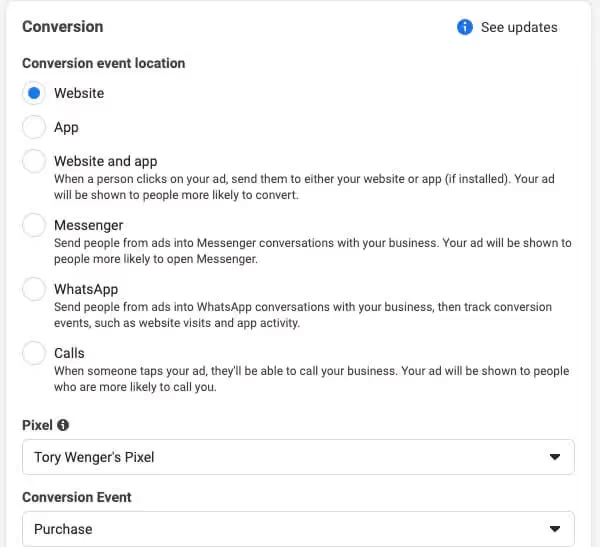
Facebook’s algorithms will then show your ads to users who are more likely to make a purchase based on the data collected by the Pixel.
Lookalike audiences
Just like the Pixel optimization option, we can also use the Meta Pixel to optimize our audience targeting strategy. One of the ways we can do that is with a lookalike audience.
Essentially, this feature allows you to tap into a new group of potential customers that closely resemble your best existing customers (or Page followers, leads from your CRM, etc.). Facebook uses a source audience - in this case, people who have visited your website or those who have already made a purchase and have been tracked via the Pixel - and finds other Facebook users who share similar characteristics or behaviors.
By utilizing lookalike audiences, you can expand your reach by targeting people who are likely to be interested in your business, even if they've never interacted with your brand before. This means your advertising budget can be spent more efficiently, as the chances of engagement and conversion are typically higher with this group.
While we don't have the time to cover all the ways you can create and use lookalike audiences in your strategy in this post, we have a lookalike audience guide here on how to do just that.
Retargeting audiences with Dynamic Ads
While lookalike audiences are one aspect of improved targeting we get with the Pixel, we're also privy to an even bigger and more exciting method—retargeting with Dynamic ads (now called Meta Advantage+ catalog ads).
Dynamic Facebook ads are a type of advertisement that automatically shows different content to different people based on their interests, past behaviors, and interaction with your website or app. These ads utilize the product catalog you upload on Facebook and deliver personalized ad experiences to users.
Here's where the Facebook Pixel becomes vital. The Pixel collects data about how users interact with your website—what pages they visit, which products they view, what they add to their cart, etc. This data is then utilized to tailor Dynamic ads to individual users.
For instance, if a user visits your online store and views a particular product but doesn't make a purchase, the Pixel will record this action. Later, when that user is browsing through their Facebook feed, they might see a Dynamic ad featuring the exact product they viewed on your website.
In essence, the Facebook Pixel serves as the backbone of Dynamic Facebook ads by collecting the necessary user data and providing actionable insights, making your advertisements significantly more personalized and effective.
Analyzing Facebook Pixel data
Aside from the targeting benefits, we also get access to a whole host of analytics capabilities when our Pixel has been created. Here are just a few of the things you can analyze with Pixel data.
Facebook Pixel analytics
While you might be using several tools to track website actions (like Google Analytics or Shopify's own internal dashboard), Events Manager lets you track the number of actions taken on your website each day.

This data can be incredibly useful when trying to make sure your metrics are matching actual actions, as well as seeing peaks and valleys in your data set. For example, if you see a steady decline in actions triggered, you might either be experiencing a decline in your ad performance or issues with your Pixel installation.
Understanding Pixel-specific metrics
There are a nearly overwhelming amount of Facebook metrics available, especially when it comes to the ads side of the platform.
However, unless you're using the Facebook Pixel to track not only the number of actions but the revenue attached to those actions, you'll never know if your ads are even turning a profit.
And that's a very dangerous situation to be in.
Luckily for us, now that we have our Pixel installed, we have access to a ton of Pixel-specific metrics that your CFO and CMO want to be aware of:
- Offsite Conversions- These are the number of actions that happen off of Facebook - i.e., the events that are triggered by your Pixel. These actions include all of the standard and custom events we created before.
- Cost per result (or CPA) - measures your campaign's cost-effectiveness by dividing money spent by total results. It's crucial for gauging campaign efficiency, identifying the best-performing audiences and creatives, adjusting focus, spotting opportunities, and ensuring profitable ad spend.
- Cost per Conversion assesses the costs of various campaign actions, not just the main goal. In an eCommerce context, it can track costs for events like page views, cart additions, payment info submissions, and purchases. Analyzing these can help identify areas for improvement.
- Conversion rate informs about conversion capacity (how many people are clicking and taking x action), sets benchmarks for traffic goals, identifies funnel drop-offs for optimization, and, together with cost per result, helps gauge overall campaign performance.
..and that's certainly not all. If you want a full guide on which Facebook ad metrics matter and which you can ignore, you can check out our blog post on the topic.
Meta Pixel best practices
While the Pixel has an incredible amount of perks, there are a few things you need to keep in mind to make sure you're using it to its full capacity.
- Be sure to comply with privacy policies and GDPR regulations. Since we're handling data about individuals, it's important to remember that you must comply with all legal privacy policies, including GDPR, when implementing the Meta Pixel.
- Regularly review and maintain Pixel health. Just like with our own bodies, we must regularly review our Pixel data to make sure it's flowing steadily through the system. The best way to do that is by using the Meta Pixel Helper Chrome extension we mentioned above
- Troubleshoot and resolve any issues with the Facebook Diagnostics Tool. If you find an issue when reviewing your Pixel code, you'll want to fix that as soon as possible. You can do that by going to your Events Manager and selecting the Diagnostics tab at the top of the screen
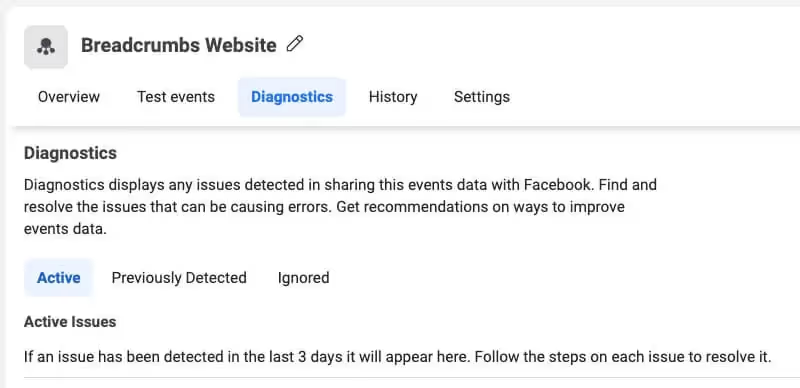
Here, you'll see a list of any current or past issues you have had with your installation. You'll also find tips on how to fix that issue and get the green light for your setup.
- Implement server-side tracking. Even though we've already covered the other ways to fill in the data gaps, we still have one trick up our sleeve: server-side tracking. By using our own servers instead of using third-party ones (like the Conversions API does through partner integrations), we can make the switch from using third-party servers to using first-party servers (aka our own). While this is a bit more complicated to set up than the rest, it's the final piece in our tracking tool shed that can really make a difference in the data available to us.
- Implement offline conversions. While much of the data will be tracked with your Pixel and the Conversions API we learned earlier, given the iOS 14 changes, you still might find that some data is slipping through the cracks. To this end, implementing Facebook's offline conversion tracking will help sync your sales database to the Pixel to find any missing conversions.
Meta Pixel FAQs
How do I share my Meta pixel with other Business Manager accounts?
If you have an agency or a media buyer running your Facebook ads for you, you’ll need to share your Meta pixel with them.
- Go to your Events Manager, select “Data Sources,” and choose your pixel.
- Go to the “Settings” tab and scroll down to “Sharing.”
- Click “Share with a business” and then add your partner’s business account.
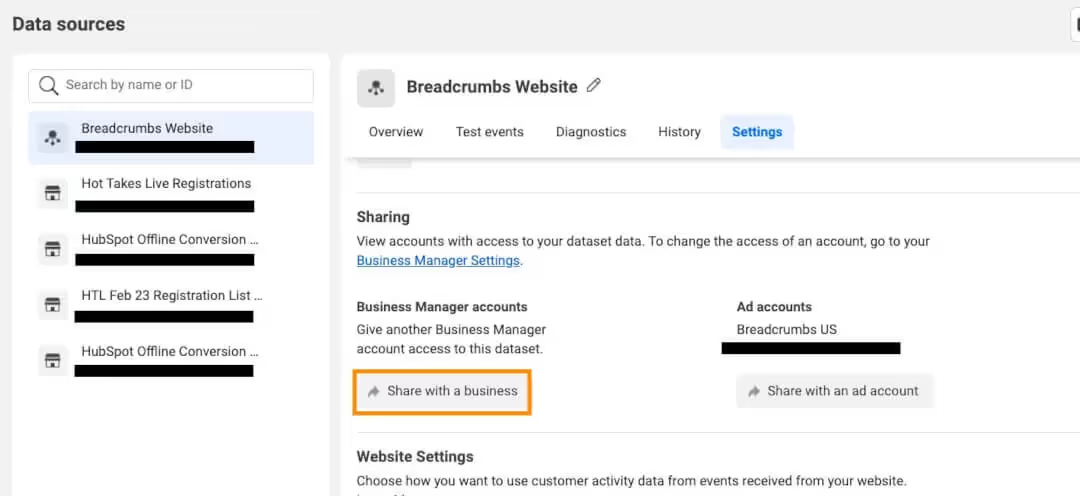
Note that you need admin permissions in order to share your Pixel with another Business Manager.
On the same screen, you can also share your Pixel with another ad account in case you have more than one.
Note that when sharing your Pixel with a partner, Facebook requires you to declare the type of business relationship you have with this partner, reaffirm the acceptance of the Business Tool Terms of Service, and, of course, get an agreement from your partner’s business.
If you want to grant other people in your business access to your Meta Pixel, you can do it via your Business Manager.
Go to “Business Settings,” and then under Users, select the People tab and choose the person you want to have Pixel access. You can click “Add assets” to bring up a window where you can assign the Pixel.
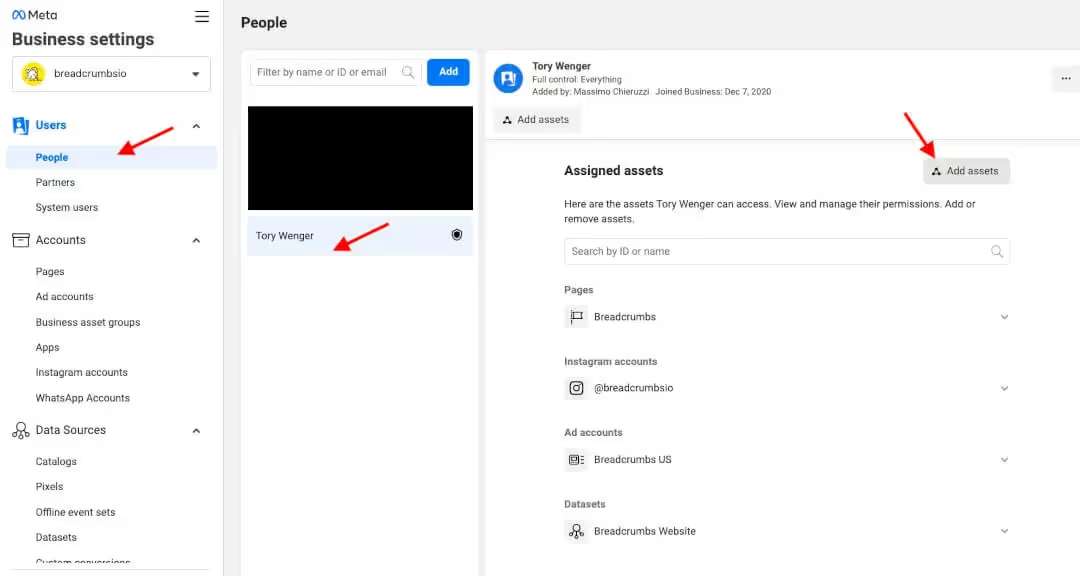
You can then select the Pixel and click “Save changes” to assign it.
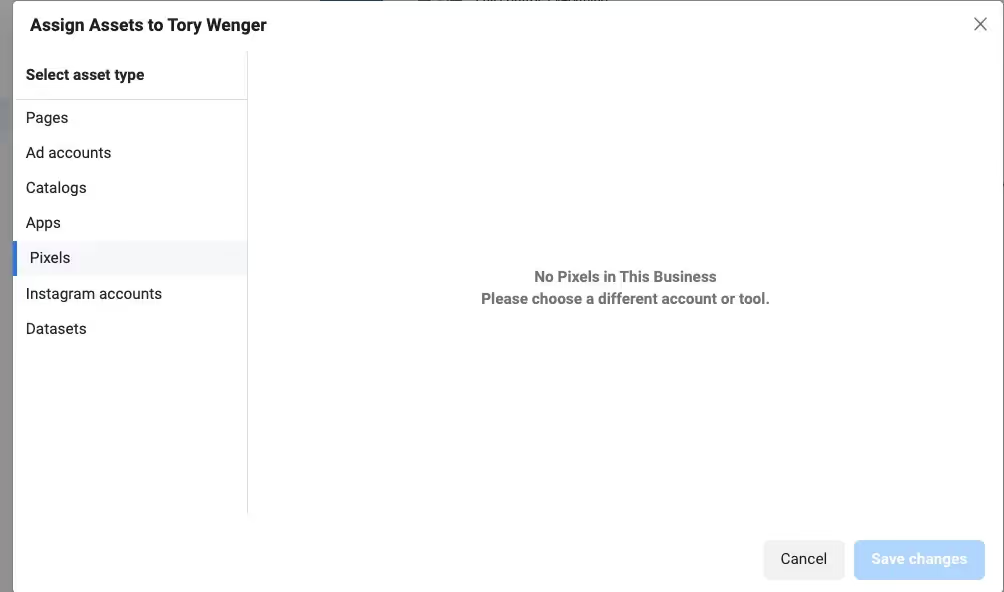
How do I change the name of my Pixel?
If you didn’t give your Pixel a recognizable name at the beginning, you can always change it. To do so, simply:
- Go to the Events Manager.
- Select Data sources and then the Pixel you want to edit.
- Click the pencil icon next to your Pixel’s name on the top of the screen.
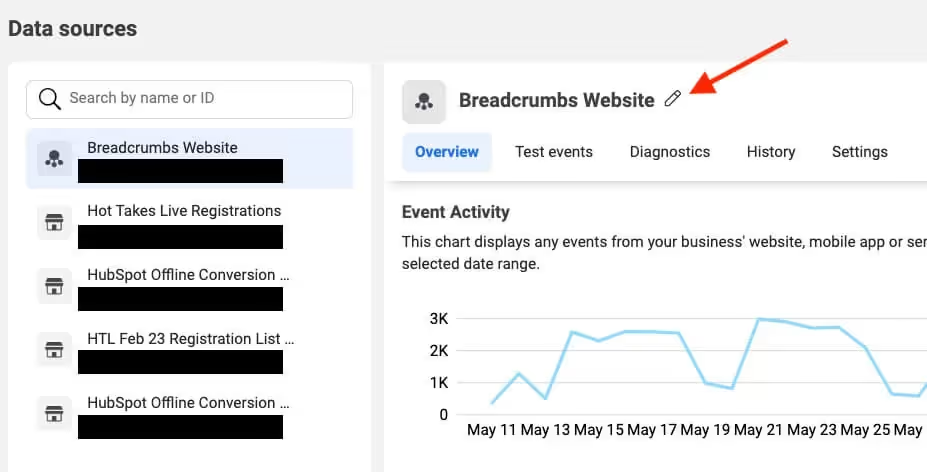
- Change your Pixel’s name and click “Save.”
When should I create traffic-allow/blocklists for my Pixel?
Allow Lists and Block Lists are two features that can be used with Facebook Pixel:
- Allow Lists: This is a list of domains where you want your Facebook Pixel to track user data. By specifying an Allow List, you're telling Facebook to only collect data from the domains you trust and want to track. It is a way to make sure that your Pixel is not misused by unauthorized domains.
- Block Lists: Conversely, this is a list of domains where you do not want your Facebook Pixel to track data. By creating a Block List, you're instructing Facebook not to collect data from specific domains. This can be useful if you believe that a domain is generating unauthentic traffic or want to avoid collecting data from certain places that are not relevant to your business.
You should use Allow Lists and Block Lists in the following scenarios:
Use Allow Lists: When you want to ensure data integrity and make sure that only authorized domains are able to send data to your Facebook Pixel. This is particularly important if you have a network of websites or working with partners and want to prevent unauthorized usage of your Pixel.
Use Block Lists: When you identify traffic from certain domains that are not relevant or might be detrimental to your data quality, you should add these domains to the Block List to prevent them from sending data through your Facebook Pixel.
As always, remember to follow Facebook’s best practices when it comes to editing this configuration.
Conclusion: Leveraging Meta Pixel for marketing success
In conclusion, navigating the installation and use of the Facebook Pixel may seem daunting at first, but as we've seen, it's a straightforward process that opens the door to a myriad of benefits. This blog post guided you through the step-by-step process of setting up the Pixel, ensuring you have the right tools to enhance your advertising efforts.
The significance of the Facebook Pixel to any marketing strategy cannot be overstated. Its ability to track and analyze the actions taken on your website allows you to understand your audience better, improve your ad targeting, and refine your marketing strategy. From conversion tracking and optimization to retargeting and lookalike audience creation, the Pixel serves as an indispensable tool to drive efficiency and effectiveness in your Facebook ad campaigns.
As you leverage the power of the Facebook Pixel, remember to continually test, analyze, and tweak your strategy based on the invaluable data you're now equipped to gather. The insights it provides have the potential to take your advertising game to new heights. Happy advertising, and here's to boosting those conversion rates!
After the iOS 14.5 update, the Meta Pixel alone can no longer give you all the data you need to make effective scaling decisions. Solution? Get accurate performance data with Madgicx Cloud Tracking (MCT).
Tory Wenger is a marketing operations whiz with 10+ years of experience mastering CRM optimization, digital marketing, and event strategy. A certified HubSpot, Facebook, and Google expert, her work has been spotlighted on top platforms like Hootsuite, AdEspresso, and Databox. When she’s not crafting winning strategies, you’ll find her gardening or painting in her home in the Florida panhandle.













